The Brazos Review: AMD's E-350 Supplants ION for mini-ITX
by Anand Lal Shimpi on January 27, 2011 6:08 PM ESTAMD has been curiously absent from the value netbook and nettop segments since Atom’s arrival nearly three years ago. These markets are highly profitable only for component vendors, as the OEMs that sell netbooks and nettops must survive on very slim margins in order to hit aggressive price points. It wasn’t too long ago that we were shocked by $699 desktop PCs, but to now be able to get a fully functioning portable PC with display at below $300 is impressive. In order for the profit equation to work out however, you can’t simply scale down a larger chip - you need an architecture targeted specifically at the type of very light workloads you expect to encounter in these segments. Underclocking and undervolting an architecture targeted at high end desktops or servers won’t cut it.
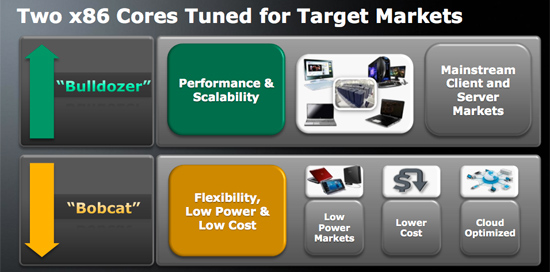
Generally a single microprocessor architecture can cover an order of magnitude of power envelopes. You can take an architecture from 10W - 100W using clock speed, voltage scaling and disabling features (e.g. cutting cache sizes). You can’t efficiently take a 100W architecture and scale it down to 1W. Intel realized this with Atom, and what resulted was a new architecture designed to span the 0.5W - 5W range. Given the constraints of the process (Atom was built at 45nm) and a desire to keep die size down to a minimum (and thus maximize profits), Intel went with a dual-issue in-order architecture reminiscent of the old Pentium - but with a modern twist.
AMD came to the same realization. For it to compete in these value markets, AMD couldn’t rely on its existing Phenom II derived architectures. The Phenom II and its relatives currently span a range of TDPs from 9W to 140W, and at the lower end of that spectrum we’re talking about some very low clock speeds and performance targets. Getting down to 1W was out of the question without a separate design.
What AMD came up with was a core called Bobcat, initially targeted for netbooks, notebooks, nettops and entry level desktops. Architecturally Bobcat is a significant step ahead of Atom: while still dual-issue, it features an out-of-order execution engine making it the Pentium Pro to Atom’s Pentium.
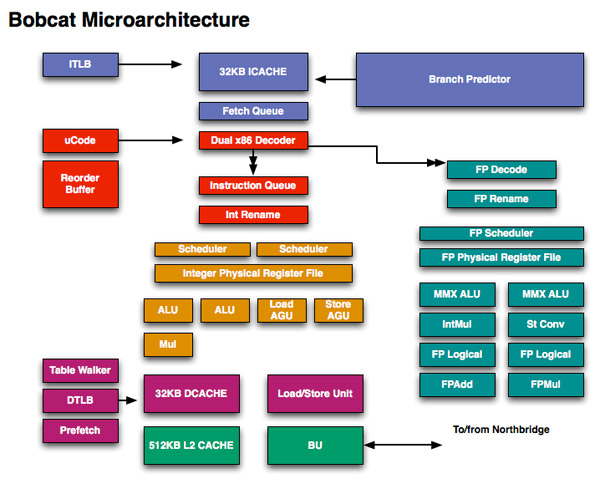
It isn’t just CPU architecture that AMD surpassed Atom with, the first incarnation of Bobcat is an integrated SoC with on-die DirectX 11 GPU. AMD calls this combination a Fusion APU (Accelerated Processing Unit) as it places both a CPU and GPU on a single die. The possible CPU/GPU combinations for Bobcat based APUs are listed in the table below:
| AMD Brazos Lineup | ||||||||
| APU Model | Number of Bobcat Cores | CPU Clock Speed | GPU | Number of GPU Cores | GPU Clock Speed | TDP | ||
| AMD E-350 | 2 | 1.6GHz | Radeon HD 6310 | 80 | 500MHz | 18W | ||
| AMD E-240 | 1 | 1.5GHz | Radeon HD 6310 | 80 | 500MHz | 18W | ||
| AMD C-50 | 2 | 1.0GHz | Radeon HD 6250 | 80 | 280MHz | 9W | ||
| AMD C-30 | 1 | 1.2GHz | Radeon HD 6250 | 80 | 280MHz | 9W | ||
AMD avoided branding its first APUs, they’re simply the AMD E-series and C-series Fusion APUs. The emphasis isn’t on the CPU or the GPU in this case, just the company name and a model number.
| CPU Specification Comparison | ||||||||
| CPU | Manufacturing Process | Cores | Transistor Count | Die Size | ||||
| AMD Zacate | 40nm | 2 | ? | 75 mm2 | ||||
| AMD Thuban 6C | 45nm | 6 | 904M | 346mm2 | ||||
| AMD Deneb 4C | 45nm | 4 | 758M | 258mm2 | ||||
| Intel Gulftown 6C | 32nm | 6 | 1.17B | 240mm2 | ||||
| Intel Nehalem/Bloomfield 4C | 45nm | 4 | 731M | 263mm2 | ||||
| Intel Sandy Bridge 4C | 32nm | 4 | 995M | 216mm2 | ||||
| Intel Lynnfield 4C | 45nm | 4 | 774M | 296mm2 | ||||
| Intel Clarkdale 2C | 32nm | 2 | 384M | 81mm2 | ||||
| Intel Sandy Bridge 2C (GT1) | 32nm | 2 | 504M | 131mm2 | ||||
| Intel Sandy Bridge 2C (GT2) | 32nm | 2 | 624M | 149mm2 | ||||
These APUs do need the aid of an additional chip - the Hudson Fusion Controller Hub (FCH). The FCH adds support for things like SATA, USB, Ethernet and Audio.The Hudson FCH is very tiny measuring approximately 4mm x 7mm for a total die size of around 28mm2.
The combination of these Bobcat based APUs and the FCH is called the Brazos platform.
Late last year AMD invited me to spend several hours with a Brazos system at its brand new campus in Austin, TX. While the preview gave us some insight into what we could expect from Brazos, I didn’t have enough time to really dive in as much as I would’ve liked to.
Earlier this month, AMD officially launched Brazos with hardware expected sometime this quarter. For the past couple of weeks I’ve been testing a Brazos mini-ITX motherboard from MSI and today, it’s time to break the silence and share the results. They are quite good.


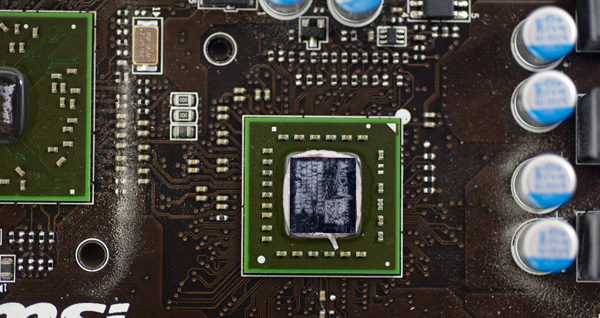
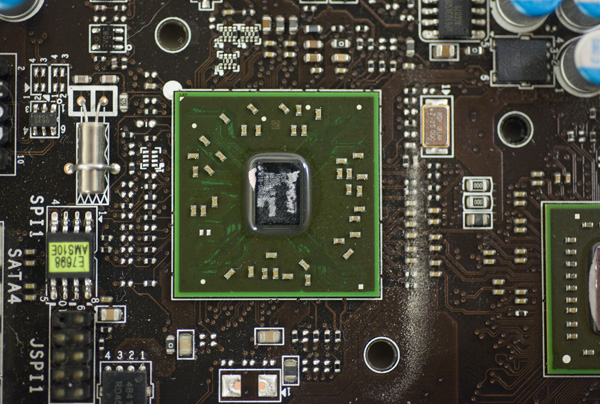
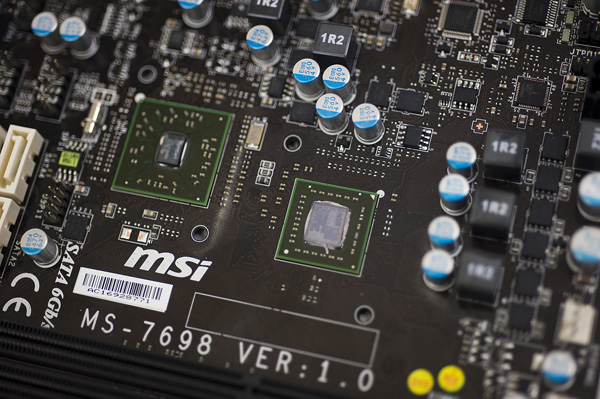
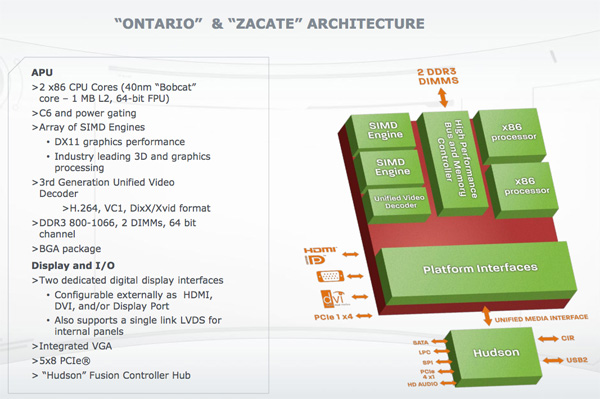








176 Comments
View All Comments
tipoo - Thursday, January 27, 2011 - link
Goodbye, crappy Atom.ssj4Gogeta - Friday, February 4, 2011 - link
@Anand:"Remember that the Atom 330 is a dual-core CPU with SMT (4-threads total) so you’re actually getting 17.2% of four hardware threads used, but 34.4% of two cores."
Why would you say that, when those 4 threads are actually running on the 2 CPU cores? Or is it that the average for the 4 threads can never exceed 50%? Only in that case your doubling of the number makes sense.
ClagMaster - Thursday, January 27, 2011 - link
This is amazing performance for an 18W processor if you really think hard about it.This rig will beat my Athlon 1700+/KT266A/DDR-266/GeForce 4200 rig I had six years ago.
AMD will sell a lot of these Bobcats after the final bugs are worked out.
Dark_Archonis - Friday, January 28, 2011 - link
No, no it's not. Intel will very soon release 17W ULV Sandy Bridge CPUs.Even a current ULV Arrandale CPU will take out a Brazos in terms of CPU performance.
Kiijibari - Friday, January 28, 2011 - link
Hahaha ... attacking tiny Zacate with a Sandy Bridge ... yes it may have triple or quadruple performance, but so will be it's price ^^Shadowmaster625 - Friday, January 28, 2011 - link
yeah and the tray price will be $188 per cpu, in qty's of 1000. Haha good luck with that.djgandy - Friday, January 28, 2011 - link
Yes I am looking forward to ULV Sandybridge. I still have a Core Duo CULV which is starting to show its age. I'm sure it is still way faster than Atom and Zacate.It may cost more but you'll have 2-3 times the CPU performance with SB. Plus it should have dedicated video decode.
coconutboy - Friday, January 28, 2011 - link
You're only talking about the speed and if that's all you need, of course focus on a much pricier alternative. Now add in power envelope and price which is the entire point of this thing; moderate performance, very low power draw, dirt cheap. AMD nailed all of that.Brazos e-350 can be built as a tiny, passively cooled unit that costs a mere $100. If my neighbor asks me to build her a new system (again), this is EXACTLY what she'd want. It'll sit quiet 'n' cool in her living room right next to the TV and cost peanuts.
Toughest part of building a ~$200-250 Brazos rig will be getting an inexpensive (but not cheaply made), passively cooled PSU and case. RAM prices are barely a concern.
sebanab - Friday, January 28, 2011 - link
"you'll have 2-3 times the CPU performance with SB" -> the things i use notebooks for don't need allot of CPU.If you do allot of PI calculations / video encoding / SETI , well , you should get a job. And when you do get a job, you will also understand why a 500$ notebook is better than a 1K$.
I hope i don't annoy anyone , but Intel really has to pay for the four years of selling Atom saying "it is good enough".
knedle - Saturday, January 29, 2011 - link
I have a job and I'm running SETI (now it's called BOINC).When I have to make decision - get computer that will give me more SETI points, or computer that will give me more "money saved" points, I go for the money. :D